With the Xiaomi Mi 11 already launched in China and slated to launch globally, it is high time all the Mi 10 variants were out of the way. After launching its first 5G phone – the Mi 10 5G – last year, Xiaomi is now out with a fourth variant of the Mi 10 series, named the Mi 10i. This phone has been launched as the Redmi Note 9 Pro 5G in China. The ‘i’ in the naming is a nod to Indian audiences, according to Xiaomi. And no, unlike what Xiaomi may claim, the Mi 10i is NOT a flagship phone, the presence of a 108 MP camera notwithstanding.
The Mi 10i brings forth features seen on the flagship Mi 10, such as the 108 MP primary camera and 5G support, but at a relatively affordable price point.
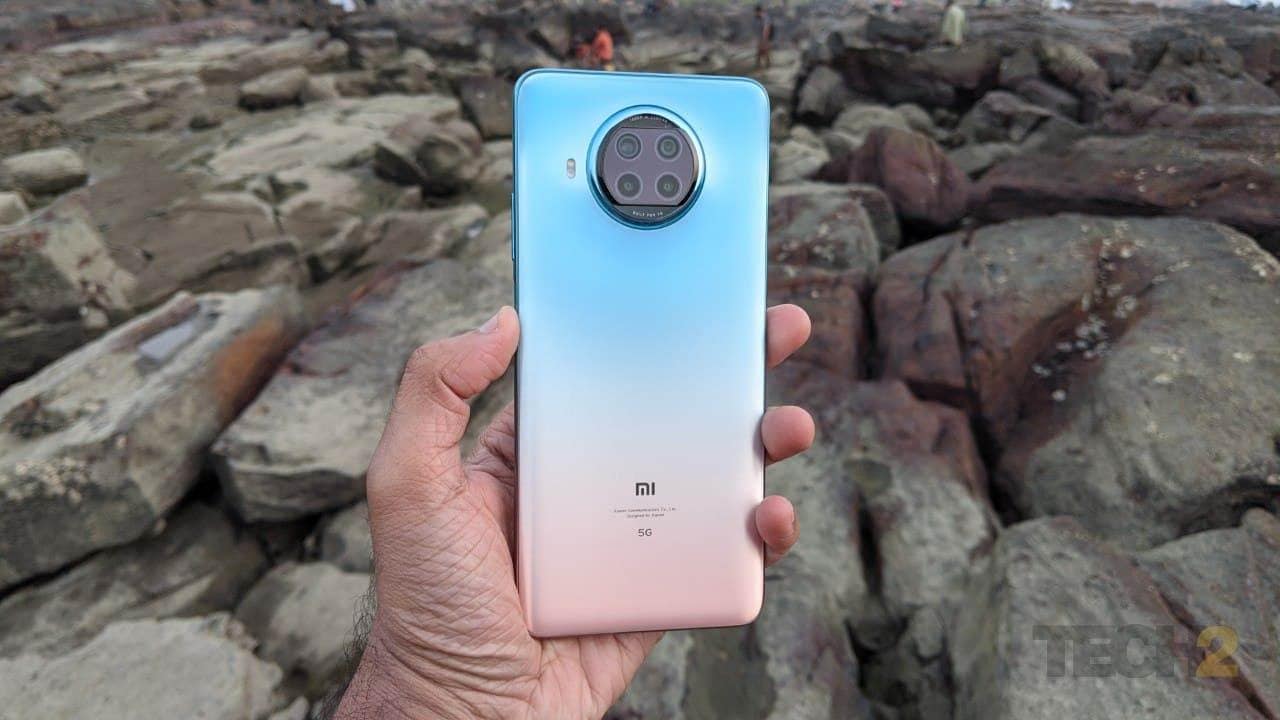
Xiaomi Mi 10i. Image: Tech2/Nimish Sawant
Xiaomi Mi 10i Price
Xiaomi Mi 10i has been launched at a starting price point of Rs 20,999 for the 6+64 GB variant (which will launch at a later date); Rs 21,999 for the 6+128 GB variant and Rs 23,999 for the 8+128 GB variant (the device under test). Given the pricing, the phone doesn’t house a top-shelf chipset. However, the Qualcomm Snapdragon 750G still features 5G, not that it matters in India yet. And the Mi 10i retains the 108 MP camera with a new sensor.
Build and Design
Just like the Mi 10, the Mi 10i looks stunning, thanks to its dual tone frosted glass back. Xiaomi calls this “Pacific Sunrise” as you can see an orange colour at the base transitioning into blue, just like a sunrise scene would. The camera module arrangement is different from the Mi 10, with all the four cameras housed inside a circular module placed in the top-central position. It does remind one of a certain OnePlus device. It doesn’t jut out as much as we had seen with the Mi 10. Thanks to the frosty glass finish, the phone is a bit too slippery to hold and I felt much more comfortable after putting on the transparent silicone case included in the box. At 215 grams, it is a tad heavy to hold on to for longer durations, but the weight distribution is even.
.jpg)
Thanks to the frosty glass finish, the phone is a bit too slippery to hold and I felt much more comfortable after putting on the transparent silicone case included in the box. Image: Tech2/Nimish Sawant
With Corning Gorilla Glass 5 on the front and the back, the Mi 10i is well protected from minor scratches. This is also a phone that comes with IP53 protection against splashes of water. The frame sandwiched between the glass front and back is made of plastic – we must accept that there will be some cost cutting somewhere. The Mi 10i sports a 6.67-inch display with a punch hole camera placed in the centre. The earpiece speaker is present at the very top edge, which has become the norm these days.
On the right side you have the power/standby button which also houses the fingerprint scanner — thank goodness for this. Above this is the volume rocker button. On the left side you have the dual hybrid SIM card slot. At the base, you have the 3.5mm headphone jack, USB Type C charging and data transfer port, and the speaker grille.
As Xiaomi has employed the Samsung HM2 sensor for the primary camera, it has managed to keep the camera module slimmer than the Mi 10. The ring surrounding the camera module is the only glossy portion on the rear. But due to the sharp flat cut of the module on the top and the bottom of the four cameras, there is some space left for dust to collect in. Thankfully, it’s easy to clean.
On the whole, the Mi 10i carries the visual elegance that one would associate with flagship devices. With the added IP rating and Gorilla Glass front and back glass, it makes the device more sturdy.
Specifications
Display: 6.67-inch IPS LCD display with 2400 x 1080 pixels with 120 Hz display
Chipset: Qualcomm Snapdragon 750G
Graphics: Adreno 619 GPU
RAM + Storage in GB: 6/64, 6/128, 8/128 (under test) with UFS 2.2 storage
Expandable storage: Yes
Primary Camera: 108 MP with f/1.75 aperture with sensor size 1/1.52-inch
Secondary cameras: 8 MP Ultrawide with f/2.2 aperture + 2 MP Macro with f/2.4 + 2 MP depth with f/2.4 aperture
Selfie Camera: 16 MP with f/2.5 aperture
Battery: 4,820 mAh
Software: Android 10 with MIUI 12
Colours: Pacific Sunrise, Midnight Black, Atlantic Blue
Display
Let’s get the first bone of contention out of the way — the Mi 10i sports an IPS LCD display. This may rub some people the wrong way, as the Mi 10i operates in a price segment where AMOLED displays are expected. To be fair, the IPS LCD display does not disappoint on most fronts. The only areas where I did find things to be lacking were when I was outdoors in bright sunlight. When trying to compose photos, the brightness level on the Mi 10i wasn’t that great, causing me to squint. The other area where I noticed this shortcoming was when watching movies and videos – the black strip around the front camera isn’t pitch black and the backlight bleed is noticeable in dark scenes.

Image: Tech2/Nimish Sawant
These two issues aside, I found the display to be great for day-to-day use. I kept the refresh rate at 120 Hz and things were smooth, as promised. The Mi 10i features “Intelligent AdaptiveSync” which switches the display from 30 Hz – 120 Hz depending on the content on the screen. This does not require any manual input from the user end. Here’s the breakup:
- For movies at 24p: 48 Hz
- Recording videos at 30/60 Hz: 30/60 Hz
- Scrolling information on Twitter/Instagram and other sites: up to 120 Hz
- Gaming 60/90/120 fps: up to 120 Hz
The display is WideVine L1 certified with HDR10 and HDR10+ support. This effectively means that you can stream content at full HD resolution with rich detail. At the time of reviewing, Netflix’s HDR content wasn’t visible. Hopefully, that will be fixed in future updates.
Watching movies, gaming or just reading long-form content on the display was a good experience. As has become standard with most smartphone displays, you can choose to have navigation buttons or full screen navigation enabled. Apart from watching movies, I didn’t really mind the IPS LCD display. It will, however, surely be a deciding factor for many prospective buyers.
Performance and OS
While Xiaomi is claiming that the Mi 10i is “the perfect flagship”, that’s not really true. For starters, it houses the mid-range Qualcomm Snapdragon 750G with Adreno 619 GPU, which isn’t their top-of-the-line chipset. The device under test had 8 GB RAM. Unfortunately, while testing the device, the MIUI 12.0.3 Stable update disabled most benchmarks such as Geekbench 5 and 3D Mark, so there are no comparative scores to show. The MIUI 12.0.4 update wasn’t available on my device for reasons best known to Xiaomi.
In terms of daily usage, I didn’t notice any issues with the handset. The Mi 10i ran most apps thrown at it without a hitch, the 120 Hz display was impressive and the physical fingerprint scanner was wicked-fast.
Call quality is good on the Mi 10i, with the earpiece speaker being sufficiently loud. Thanks to the stereo speaker support, I enjoyed a few Netflix shows without needing earphones. While the sound output is loud, the experience is understandably better when you plug in earphones. Mi 10i does include a 3.5 mm jack.
Gaming on the device was smooth, barring a few glitches on CoD Mobile at its highest settings. It ran high-end games just fine, and only after a sustained gaming session on high settings did the phone get warm to the touch. At no point did this cause any strange behaviour or app shutdown.
The Mi 10i runs Android 10 (1 Nov 2020 patch) with MIUI 12 atop it. While at first launch there is a lot of bloatware on the device, you can thankfully uninstall it. Xiaomi’s local app store, GetApps’ updates are annoying. Honestly, it isn’t needed when you have a functioning Play Store. The ‘Games’ bundle is an embarrassment, with copycat variants of Candy Crush and Fruit Ninja, among others. Opening that folder nudges you to download even more apps. I thought MIUI 12 would be a more polished experience. But if you are going for a Xiaomi device, you have to be mentally prepared for these annoyances.
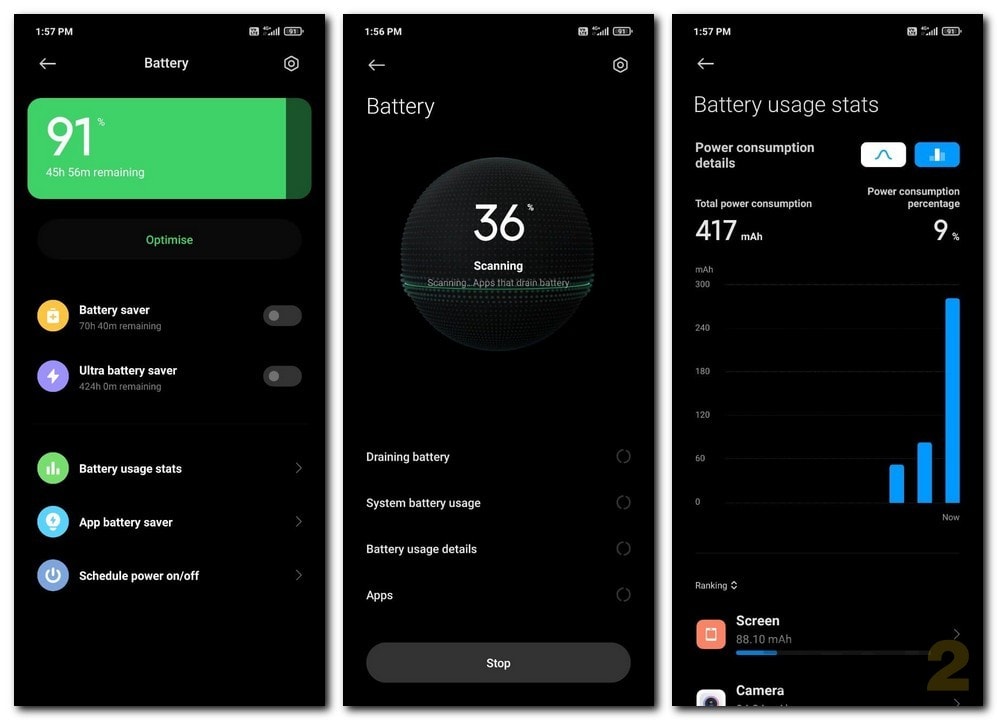
The battery section on MIUI 12 looks good. Image: Tech2/Nimish Sawant
You still have a bunch of Xiaomi’s system apps and those can’t be uninstalled. There weren’t many unsolicited ads that I came across, so it’s a definite improvement over MIUI 11. There were a few instances where I got a prompt asking me to follow Mi India on Instagram, which I declined; I don’t understand why Xiaomi does these cheeky things, giving us reviewers an opportunity to nitpick in what could otherwise be a user-friendly UI.
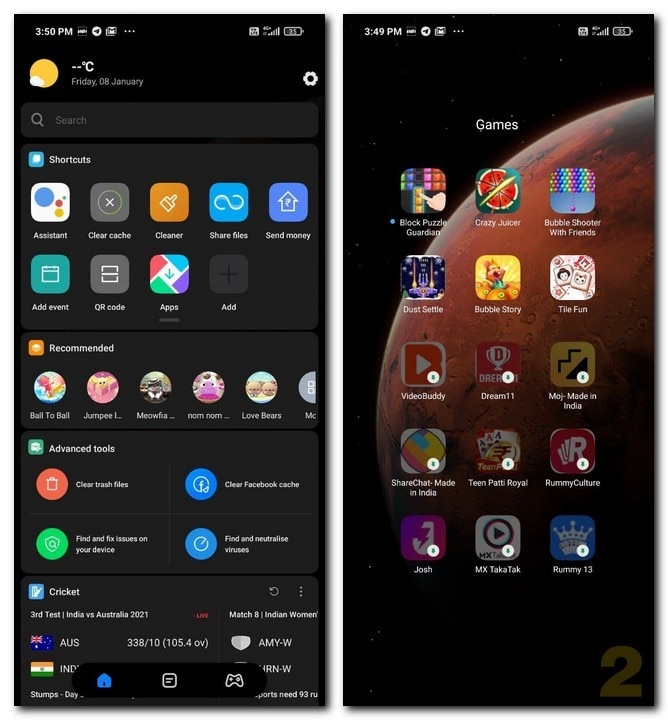
Bloat the MIUI can do without. Image: Tech2/Nimish Sawant
Camera
Xiaomi Mi 10i sports a new variant of the 108 MP Samsung HM1 sensor that was first seen on the Mi 10 5G, called the HM2 sensor. It comes with a 1/1.52-inch sensor and Xiaomi claims it’s more compact than the HM1 sensor, which helps with a reduced camera bump. In addition to the primary 108 MP camera, the Mi 10i has an 8 MP ultrawide camera and a 2 MP depth sensor camera. The 2 MP macro camera is pointless and just there to add to the camera count. Pairing a flashy 108 MP camera with an 8+2+2 MP configuration of secondary and tertiary cameras just looks odd on paper.
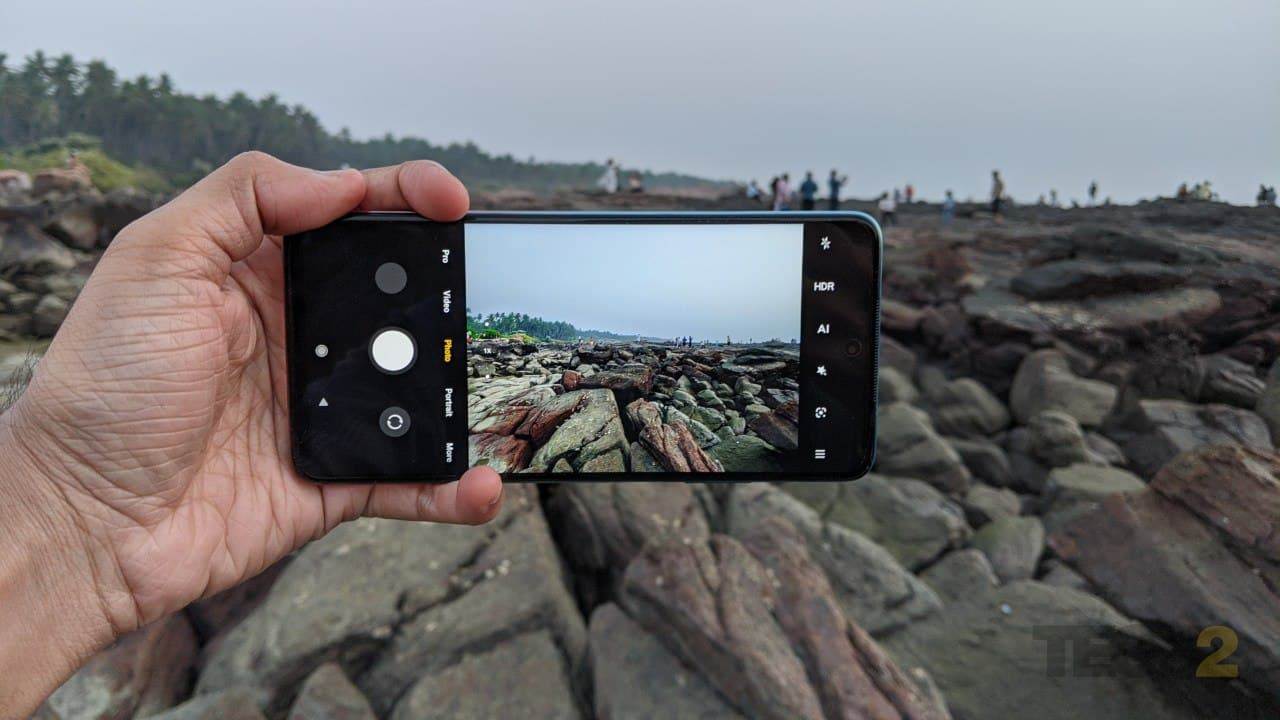
Apart from the primary 108 MP camera, the other cameras aren’t that impressive. Image: Tech2/Nimish Sawant
On the video front, the Mi 10i supports up to 4K 30fps resolution along with 1080p at 30/60 fps and 720p at 30fps. Sadly, there’s no optical image stabilisation, only electronic image stabilisation. There’s a 16 MP selfie camera with the bells and whistles of beautification mode and filters.
Apart from the primary 108 MP camera, the other cameras aren’t that impressive. The 8 MP camera takes decent ultrawide shots during daylight, but the quality drops significantly when used indoors or in low light situations. The macro camera, as I have weighed in earlier on many occasions, only does the bare-minimum to justify its presence. Image quality is poor and you can forget about using it in low light situations, unless you actually want a blotchy mess. The Mi 10i does offer various zoom options, but they are all digital zooms, so even on a 2x zoom photo, you will notice unnecessary smoothening and softness, irrespective of the lighting situation.
Click here to see the camera samples:
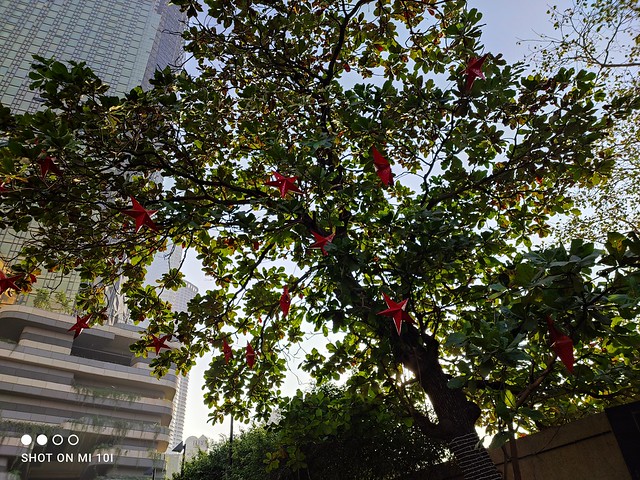
The camera interface is a lot more intuitive than it was in MIUI 11. Every mode has quick, actionable settings right at the top. You can quickly select the video shooting modes, switch to ‘SuperMacro’ modes on the still camera, adjust aspect ratios, set burst timers and much more. The ‘Timed Burst’ mode is an interesting feature which lets you shoot up to 600 photos in up to 60 secs. ‘Tilt/shift’ mode adds a nice aesthetic touch to your photos as well. ‘Pro’ mode lets you adjust WB, focus, shutter speed, aperture and EV as well as activate RAW mode, focus peaking and exposure verification.
The Mi 10i does a good job with daylight photography. Images turn out packed with details and there wasn’t much purple fringing noticeable. In the regular mode, you get 9-in-1 pixel-binned images, which means the resolution of the image will be around 12 MP. You need to select the 108 MP mode manually to click 108 MP photos. While shooting in the regular mode is fast, when shooting 108 MP images, you will notice a slight delay between shots as the smartphone processes the images. Given good lighting conditions, the 108 MP images are really good. For instance, given below is the 100 percent crop of this original image. Mind you, 108 MP images could take up over 20 MB of storage per image.

100pc crop Mi 10i. Image: Tech2/Nimish Sawant
You do get various zooming options, but as mentioned earlier, it’s digital zoom which is best avoided. You do get an AI mode which you can activate, but I found it to be adding an unnatural vivid layer on things when it detected greenery in the frame. I kept it off after the first couple of days.
As the light levels drop, so does the image quality in photos. There is a noticeable softness in the images. Despite having HDR mode on, I did notice that the photographs captured weren’t able to optimise the scene, especially in tricky lighting situations. The ‘Night’ mode does help to some extent, delivering a brighter image, but that’s about it. Shooting a 108 MP image will also amplify the noise that’s captured, which is noticeable when you pixel peep. The thing that was undesirable was the unnatural pixel sharpening seen in low light photos. I would say the ‘night’ mode performance is strictly OK for the Mi 10i. A year old Pixel 3a XL delivers better low light photos than the Mi 10i, so that should tell you something. I get that it’s the 9-in-1 pixel binning at work, but the output looks unnatural. It’s anyone’s guess if this can be fixed in future software updates.
The Mi 10i sports a 16 MP selfie camera, which is a step down from the 20 MP one seen on the flagship Mi 10. Selfies generally turn out well in daylight and even the portrait mode works fine (with temperamental edge detection). There are beautification modes which I left untouched, as they tended to be too aggressive for my liking. When shooting selfies in indoor situations or in low light, the flaws of the camera and image processing become amply clear.
When shooting in daylight, the videos turned out well and detailed so long as you shot from a steady position or with minimal movement. Due to the lack of OIS, walking and shooting led to some jarring footage. The best mode to shoot in is 1080p 30/60 fps. Use the 4K shooting mode only if you will shoot from a steady position, else even breathing while shooting leads to shaky footage. As the light levels drop, the footage becomes progressively softer, with night shooting leading to average video quality. Long story short, the video camera on the Mi 10i is fine for short social media videos, but don’t expect anything more. Xiaomi has also provided a ‘Vlog mode’ which lets you make quick, short, social media-friendly videos.
The Vlog mode on Mi 10i lets you shoot interesting short videos.
Battery
I had set the refresh rate on the Mi 10i at 120 Hz, so my battery life usage will reflect that setting. You can easily extract a little over a day on a single charge with the Mi 10i. Heavy usage involving an hour of gaming would bring the battery down to around 10 percent by the time you go to bed. With regular usage involving calling, messaging, web surfing and a few hours of video streaming, I could easily extract a day and half with the Mi 10i. It took around 70 mins to go from 5 percent to 100 percent. Even a mere 20 mins of charging will give you enough juice to last for a few hours. Battery life was fine during the 10 days that I used the device. I got around 14 h 50 mins on the PC Mark for Android battery testing benchmark.
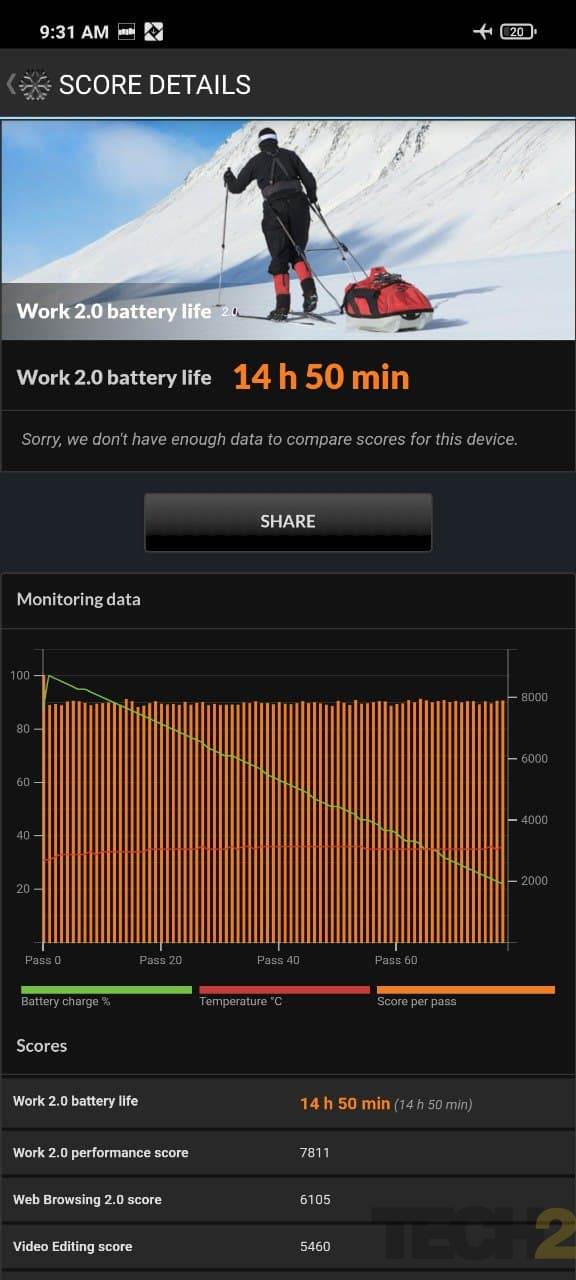
PC Mark for Android benchmark
The battery section of MIUI 12 provides impressive visual stats and you can also optimise the battery on the go. There is the ‘Ultra’ battery saving mode as well, which lets you keep only certain apps and services on, in case you need to extend battery life for emergency purposes.
Verdict and Price in India
The Xiaomi Mi 10i starts at Rs 21,999 for all practical purposes (there is no clarity as to when the Rs 20,999 priced 6+64GB variant will be out). At this price point, the Mi 10i is worth it if you keep your expectations in check. The phone offers a lovely design, decent display, good day-to-day performance, ample battery life and a very good daylight camera. The lack of AMOLED display at this price point may rile some buyers, but honestly, the IPS LCD panel with the 120 Hz adaptive display isn’t bad. MIUI 12 could have certainly done away with some bloatware, but on the whole, it’s better than MIUI 11.
Low light photography and videography isn’t its strongest suit. This was the only area where the Mi 10i lacked in appeal and this can be a deciding factor for many buyers. It also makes a strong case for why just having a large megapixel count on the camera does not translate to excellent photos across situations.
The only competition to the Mi 10i, apart from older Xiaomi and POCO devices is the OnePlus Nord, which has a slightly faster processor and an excellent user interface in the form of OxygenOS. MIUI can’t quite match the polish that OxygenOS offers. In the camera department, the Mi 10i does have some edge due to the new sensor.
While the Mi 10i is a good device, I honestly can’t figure out what Xiaomi’s plan is. A product that was launched under the Redmi branding in China, being sold as a Mi product with a pricing which competes with higher-end Redmi phones reflects an identity crisis. In the past too, a Redmi device from China was sold under the POCO brand here. It does nothing but confuse the consumer — unless that is the aim of such demarcations. What next? A sub-20k Mi device? It puts a big question mark on the Redmi K-series lineup as well. I won’t even talk about the POCO lineup, as that’s branched out on its own.
That Xiaomi has been compelled to populate the 20-25k segment with multiple phones across multiple brand names to provide an answer to the OnePlus Nord, speaks volumes. Xiaomi is behaving no different than Samsung in the sense that both brands are bombarding all segments with as many devices as possible. In a post-COVID world, is this excess really needed? I had ended my Mi 10 review with the question: Will Xiaomi be able to continue its disruption juggernaut in the value flagship segment? It looks like Xiaomi wants to play safe even with its Mi-branded phones, taking advantage of markets where it can sell volumes.
Find latest and upcoming tech gadgets online on Tech2 Gadgets. Get technology news, gadgets reviews & ratings. Popular gadgets including laptop, tablet and mobile specifications, features, prices, comparison.

Post a Comment